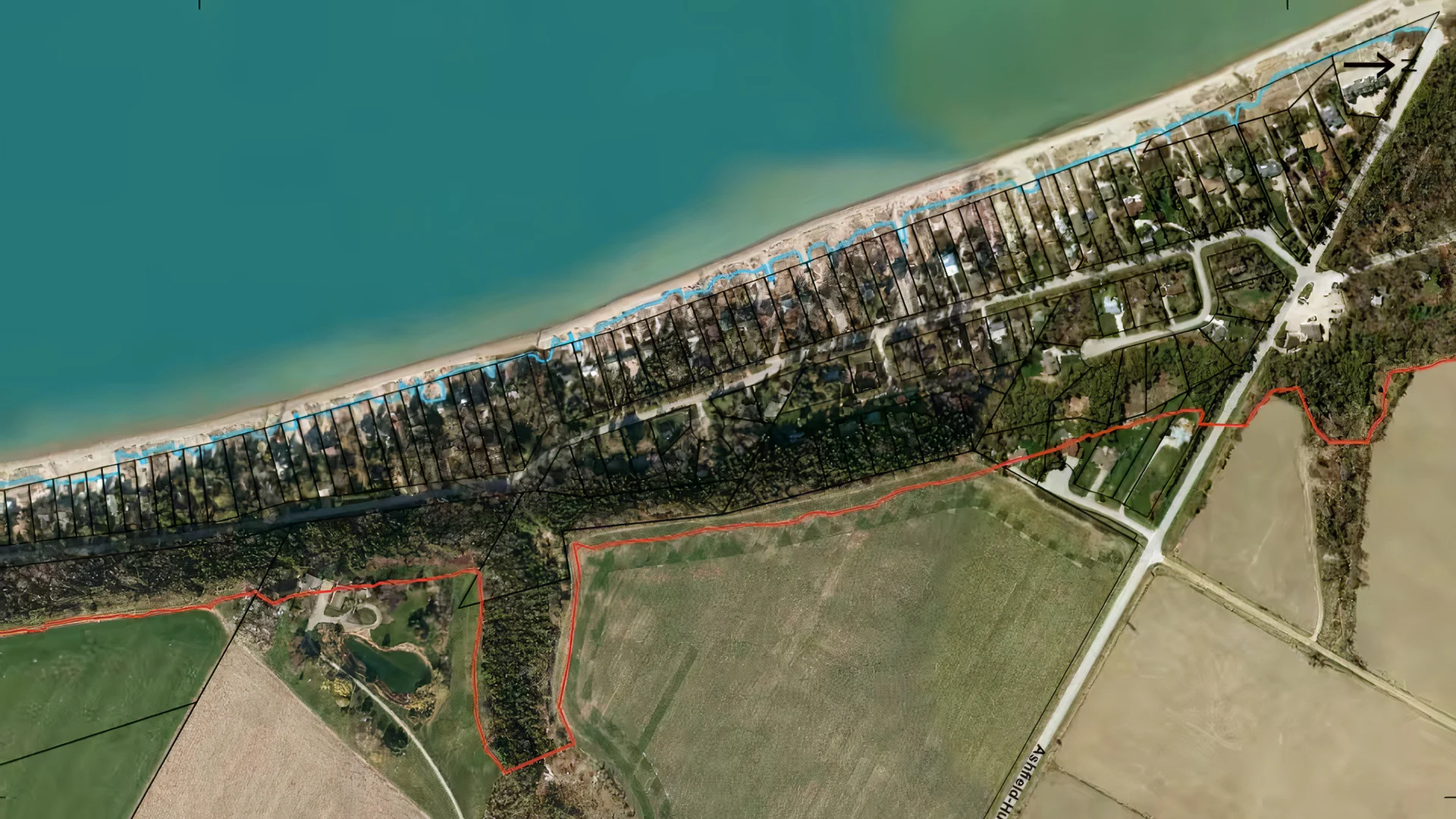
How will Lake Huron's shoreline look in 100 years? Here's the map
Shoreline change is a problem plaguing many communities on the Great Lakes, as locals watch sections of it slip into the water.
Now, the Maitland Valley Conservation Authority in southwestern Ontario has created urgently needed maps showing the huge impact of these shifts in temperatures and weather — large swaths of Lake Huron's shoreline could be under water in 100 years, including cottages, waterfronts, and a marina.
"It's really, to me, the most jarring thing to see," said Patrick Huber-Kidby about land that's already gone.
Huber-Kidby is supervisor of planning and regulations with the conservation authority, located along the southeastern edge of Lake Huron north of London.
The maps are for municipalities and the county to have better information for future planning, and they're also sharing them with the public
Huber-Kidby said homeowners, cottagers and others living on the lake have "seen how much land has disappeared: 10-20 metres in some areas. It's an area of land as deep as some people's subdivision lots that's gone now, that's in the lake."
See the map here.
To build the map, the authority spent three years consulting with geoscientists and engineers, gathering detailed elevation information and wave modelling.

Shoreline hardening, seen in this rock wall north of Grand Bend, Ont., is one of the ways landowners and municipalities are trying to protect shorelines. (Allison Devereaux/CBC)
Putting a price on shoreline hazard
Reaction from people on the shoreline is mixed, said Huber-Kidby.
Some landowners and cottagers are looking for ways to slow the erosion, asking, "What can I plant, how can I build, what can I do to not have this be an issue for me in the future?"
Others are "quite passive," he said, recognizing it's a dynamic shoreline that's moving inland.
"They just say, 'Well, it looks like based on the mapping, I've got another 20 years, 30 years, maybe another 50 years with my cottage. That's it.

Huber-Kidby says landowners and cottagers are looking for ways to slow the erosion of land along the Lake Huron shoreline, while others are 'quite passive,' recognizing it's a dynamic shoreline that's moving inland. (Submitted by Patrick Huber-Kidby)
"The best thing, really, is to move outside the hazard," he said. "In an ideal scenario, there's room for those cottages to simply move back. As the land disappears into the lake, there is room to literally pick the cottage up and move it back, outside that hazard."
Researchers are trying to capture the dollar value of what's at risk. They're gathering property values for lands, buildings and infrastructure to get a picture of the anticipated tens of millions of dollars inside the erosion hazard line.
Water levels up, lake ice down
The bluffs found along southeastern Lake Huron — one of the areas that will be hardest hit by rapid erosion — were laid down by glaciers thousands of years ago and are slowly being eroded by waves, said Chris Houser, vice-president for research and innovation at the University of Windsor.
"We're just on this point where we've developed on them. As they accelerate, we're going to see that damage."

When a wave hits the base of the bluff, it pulls away sediment to deposit elsewhere in the Great Lakes ecosystem. This 2019 photo from Grand Bend shows the impact on the shoreline. (Allison Devereaux/CBC)
Those waves have more opportunity to pummel the shoreline for two reasons:
Rising water brings waves in closer to land, leading to flooding and property damage. As water levels rise, Huber-Kidby said, "Every expectation is that new records will be set in the future."
Lake ice: "Every year, we're seeing less and less lake ice that usually protects the coastline from winter storms," said Houser.
Huber-Kidby agrees.
"If for less of the year they have that natural protection in the winter, they're getting hit with more waves. They getting hit with more energy — and they're eroding more as a consequence," he said.
Bringing new voices to the table
With an improved map and updated data, Huber-Kidby hopes the region will be better equipped to make good decisions.
While municipalities and cottage associations have historically been considered stakeholders, he said the conservation authority is trying to bring new voices to the table, reaching out to Indigenous communities, educators, researchers, engineers and other groups.
"A number of families have been out there for multiple generations," so could have valuable input, Huber-Kidby said.
"They're on these shorelines. They've seen these storms. They're really on the forefront of seeing these impacts."

Goderich, the largest community on the map, is expected to experience more flooding than erosion. Huber-Kidby says this is due to the town's heavy shoreline hardening and protection. (Maitland Valley Conservation Authority)
Getting a snapshot of possible rapid bluff retreat is a priority, with other conservation authorities reaching out to Maitland Valley to replicate their modelling.
Huber-Kidby said the difference was using climate change forecasting.
"It's an actual element of the mapping, it affects where lines are on the map. Historically, climate change was in there, but a paragraph at the end of a report — it's not good enough anymore."

Chris Houser, interim vice-president for research and innovation at the University of Windsor, is researching the sediment bank for Lake Erie's north shore. (Mike Evans/CBC)
For now, a map in hand can help with the path forward.
"These systems are dynamic," said Houser, who is researching changes to Lake Erie's north shore to get a snapshot of how sediment is moving.
"So we can harden the shoreline,we can plant dune grass, we can do nature-based solutions. But it's still going to be changing.
"Are the lakes going to increase because there's going to be more precipitation? Are the lakes going to decrease because we're going to go into greater and greater drought? We don't know," he said.
"What we need to be able to do is say, 'This is a very dynamic coast. It's going to change into the future.' We need to make sure that we are ... working on that coast, that we are living on that coast, in a way that recognizes that change."
This article, written by Allison Devereaux, was originally published by CBC.
Thumnbail image: In this map, everything west of the red hazard line is expected to be unstable or entirely within the water, says Patrick Huber-Kidby, supervisor of planning and regulations with the Maitland Valley Conservation Authority in southwestern Ontario. (Maitland Valley Conservation Authority)











